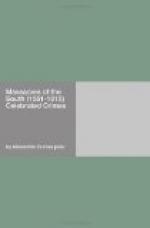Nevertheless, whatever were the hopes of one party or the fears of the other, nothing had as yet occurred to disturb the prevailing tranquillity, when, on the 19th and 20th of July, 1789, a body of troops was formed in the capital of La Gard which was to bear the name of the Nimes Militia: the resolution which authorised this act was passed by the citizens of the three orders sitting in the hall of the palace.
It was as follows:—
“Article 10. The Nimes Legion shall consist of a colonel, a lieutenant-colonel, a major, a lieutenant-major, an adjutant, twenty-four captains, twenty-four lieutenants, seventy-two sergeants, seventy-two corporals, and eleven hundred and fifty-two privates—in all, thirteen hundred and forty-nine men, forming eighty companies.
“Article 11. The place of general assembly shall be, the Esplanade.
“Article 12. The eighty companies shall be attached to the four quarters of the town mentioned below—viz., place de l’Hotel-de-Ville, place de la Maison-Carree, place Saint-Jean, and place du Chateau.
“Article 13. The companies as they are formed by the permanent council shall each choose its own captain, lieutenant, sergeants and corporals, and from the date of his nomination the captain shall have a seat on the permanent council.”
The Nimes Militia was deliberately formed upon certain lines which brought Catholics and Protestants closely together as allies, with weapons in their hands; but they stood over a mine which was bound to explode some day, as the slightest friction between the two parties would produce a spark.
This state of concealed enmity lasted for nearly a year, being augmented by political antipathies; for the Protestants almost to man were Republicans, and the Catholics Royalists.
In the interval—that is to say, towards January, 1790—a Catholic called Francois Froment was entrusted by the Marquis de Foucault with the task of raising, organising, and commanding a Royalist party in the South. This we learn from one of his own letters to the marquis, which was printed in Paris in 1817. He describes his mode of action in the following words:—




